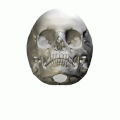| Temporal styloid process | |
|---|---|
 Right side of the skull. Styloid process shown in red Right side of the skull. Styloid process shown in red | |
 Right temporal bone and mandible (styloid process labeled at bottom) Right temporal bone and mandible (styloid process labeled at bottom) | |
| Details | |
| Identifiers | |
| Latin | processus styloideus ossis temporalis |
| TA98 | A02.1.06.047 |
| TA2 | 683 |
| FMA | 52877 |
| Anatomical terms of bone[edit on Wikidata] | |
The temporal styloid process is a slender bony process of the temporal bone extending downward and forward from the undersurface of the temporal bone just below the ear. The styloid process gives attachments to several muscles, and ligaments.
Structure
The styloid process is a slender and pointed bony process of the temporal bone projecting anteroinferiorly from the inferior surface of the temporal bone just below the ear. Its length normally ranges from just under 3 cm to just over 4 cm. It is usually nearly straight, but may be curved in some individuals.
Its proximal (tympanohyal) part is ensheathed by the tympanic part of the temporal bone (vaginal process), whereas its distal (stylohyal) part gives attachment to several structures.
Attachments
The styloid process gives attachments to several muscles, and ligaments. It serves as an anchor point for several muscles associated with the tongue and larynx.
- stylohyoid ligament
- stylomandibular ligament
- styloglossus muscle (innervated by the hypoglossal nerve)
- stylohyoid muscle (innervated by the facial nerve)
- stylopharyngeus muscle (innervated by the glossopharyngeal nerve)
Relations
The parotid gland is situated laterally to the styloid process, the external carotid artery passes by its apex, the facial nerve crosses its base, and the attachment of the stylopharyngeus muscle separates it from the internal jugular vein medially.
Development
The styloid process arises from endochondral ossification of the cartilage from the second pharyngeal arch.
Clinical significance
A small percentage of the population will suffer from an elongation of the styloid process and stylohyoid ligament calcification. This condition is also known as Eagle syndrome. The tissues in the throat rub on the styloid process during the act of swallowing with resulting pain along the glossopharyngeal nerve. There is also pain upon turning the head or extending the tongue. Other symptoms may include voice alteration, cough, dizziness, migraines, occipital neuralgia, pain in teeth and jaw and sinusitis or bloodshot eyes.
Additional images
-
 Animation. Temporal styloid process shown in red.
Animation. Temporal styloid process shown in red.
-
 Left temporal bone.
Left temporal bone.
-
 Inferior surface of left temporal bone. Styloid process shown in red.
Inferior surface of left temporal bone. Styloid process shown in red.
-
 External and middle ear, opened from the front. Right side. (Label for styloid process is bottom center.)
External and middle ear, opened from the front. Right side. (Label for styloid process is bottom center.)
-
 Left temporal bone. Outer surface. (Styloid process visible at center bottom.)
Left temporal bone. Outer surface. (Styloid process visible at center bottom.)
-
 Articulation of the mandible. Medial aspect.
Articulation of the mandible. Medial aspect.
-
 Extrinsic muscles of the tongue. Left side.
Extrinsic muscles of the tongue. Left side.
-
 Dissection of the muscles of the palate from behind.
Dissection of the muscles of the palate from behind.
-
Styloid process. Base of skull.
References
- ^ Gray's anatomy : the anatomical basis of clinical practice. Susan Standring (Forty-second ed.). . 2021. p. 737. ISBN 978-0-7020-7707-4. OCLC 1201341621.
{{cite book}}: CS1 maint: location missing publisher (link) CS1 maint: others (link)
![]() This article incorporates text in the public domain from page 145 of the 20th edition of Gray's Anatomy (1918)
This article incorporates text in the public domain from page 145 of the 20th edition of Gray's Anatomy (1918)
External links
- Anatomy photo:22:os-0407 at the SUNY Downstate Medical Center
- "Anatomy diagram: 25420.000-1". Roche Lexicon - illustrated navigator. Elsevier. Archived from the original on 2015-02-26.
- "Anatomy diagram: 34257.000-1". Roche Lexicon - illustrated navigator. Elsevier. Archived from the original on 2012-07-22.
| Neurocranium of the skull | |||||||||||
|---|---|---|---|---|---|---|---|---|---|---|---|
| Occipital |
| ||||||||||
| Parietal | |||||||||||
| Frontal |
| ||||||||||
| Temporal |
| ||||||||||
| Sphenoid |
| ||||||||||
| Ethmoid |
| ||||||||||
This human musculoskeletal system article is a stub. You can help Misplaced Pages by expanding it. |